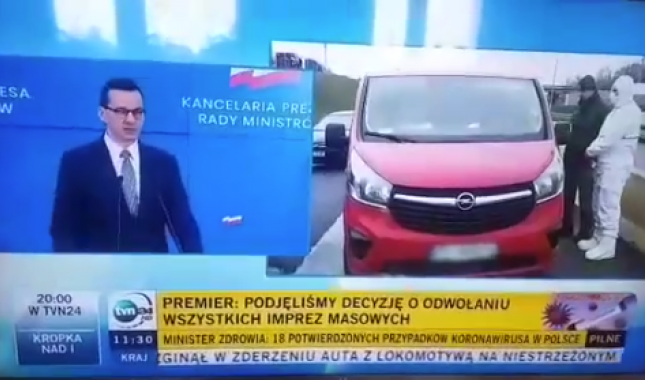Bordering the threat and the questionable logic of Poland’s ‘closed borders’ response to the coronavirus pandemic
Closing Polish borders in the times of the pandemic - how effective are these measures in protecting people from the corona virus?
 Felipe Esquivel Reed [CC BY-SA 4.0] / Wikimedia
Felipe Esquivel Reed [CC BY-SA 4.0] / WikimediaThe COVID-19 pandemic has been met with various responses in different countries. A challenging situation, for which nobody was fully prepared, continues to evoke a range of reactions, with some countries acting faster and in more restrictive ways than others: for example Spain, UK, and USA reluctantly implemented social distancing, and did so only once faced with already staggering numbers of COVID-19 related deaths, while Germany, Hungary, or Poland reacted swiftly with a multitude of far-reaching measures to ensure the minimalization of the spread of the pandemic. Poland was one of the first European Union member states to officially 'close' its borders, and follow the national isolation with far-reaching legal impositions of internal social distancing. However, the consistency and motivation for the new laws remains dubious.
On March 13th it was announced that starting on March 15th at midnight, Poland will close its borders. Since then it has also become illegal to create gatherings of more than two people, to go into public spaces without masks covering mouth and nose. Additionally, any travel deemed non urgent and not essential for one’s survival, even within cities, has been forbidden, and all stores not assessed as carrying essential supplies have been shut down. Disobedience is met with severe fines, and some repeated offences even with a threat of jail time. Many parks, boulevards, and forests have been closed, and cities and roads continue to be monitored by the national and municipal police, in certain places with the aid of the Polish military. The Polish government praises its own quick and extensive response to the virus, pointing to the quick act of ‘closing borders’ as one of the essential decisions that facilitated Poland’s supposed low number of coronavirus contamination.
But what exactly do ‘closed borders’ mean? While for the older generation of Poles the phrase evokes times of greatly limited, if not impossible, international travel under the USSR regime, in reality today’s measures are very different, and in fact, much more lenient. The borders can in fact still be crossed; however, at this time only land border control points are operational, whereas international air and waterway travel are completely shut down. In fact current measure resemble the times of regular border control from the pre-Schengen era: rather than having ‘closed’ borders, border checks are simply reinstated, with some additional limitations on who can enter the country and under what stipulations. Polish citizens as well as their families can still arrive in Poland, even though it comes with the condition of an obligatory two-week quarantine everybody must undergo, a process rigorously controlled by the national police. Additionally, foreigners with permanent and temporary residency, foreign-exchange students, and legally employed non-Poles can continue to come into the Polish territory, with the intent of staying there once arrived. The latter causes a conundrum for the many Ukrainian temporary workers, estimated to exceed one million, who are in Poland legally based on short-term employer invitations. Working in blue-collar and low-skilled sectors, as taxi and delivery drivers, grocery store clerks and cashiers, construction workers, or in agriculture, many are concerned with their inability to return to Poland once they leave. Such obstruction would essentially deprive them of the source of income and means to survive not only for themselves but often also their entire families, while staying in Poland poses the risk of overstaying the legal time permitted, the consequences of which are unavoidably deportation and re-entry ban for minimum of 6 months.
While generally international travel has been forbidden, for the first month of the borders’ ‘closure’ the Poles working in near-border regions were allowed to freely travel to and from work, when in possession of employer-issued documents. For this quite large number of Polish citizens the act of crossing the border did not involve quarantine. A similar stipulation allows international truck and delivery drivers to continue to go in and out of Poland, with no restrictions or even additional health checks at the border. Also, based on the recent decision of the Polish Parliament, they are not being tested for the coronavirus. Ironically they are a group potentially most exposed to the virus, and with frequent gas-station and loading stops, consequently constitute a high risk group to all those they come into contact with. An instrumentally economic decision, however, facilitates their uninterrupted work, in many ways making concern over their health, as well as all those they could infect, a secondary and apparently silenced concern. Based in information coming directly from the street-level Border Guards working on the Polish-German border, since the new measures aided by the military, the Polish Border Guard officers have been hardly equipped to face the reinstated border control, or the potential direct contact with people infected with the coronavirus. That fact was especially glaring in the early days of the ‘border closure’: most Border Guards did neither have gloves nor masks, or any protective gear, and continued to work shifts of 12hr and longer due to the severe understaffing on the side of the agency. As a result, those wanting to enter Poland had to wait in lines for as long as 35 hours. Despite of the constant exposure and the high contamination risk, Border Guards, called by the government to be the ‘front line defending their country’ against the pandemic, have rarely been administered tests for coronavirus.

In essence there is a clear intrinsic contradiction and lack of systematic approach to the so-called ‘closed borders’ provision in Poland. It would appear the measure was put in place instrumentally to appease the citizens in creating the notion of isolation and territorial protection. Still, the current government and the ruling PiS (Law and Justice) party, in their mission to rationalize the process of isolating Poland during the epidemic and in combination with exacerbating their anti-EU stance, claim the procedure both fully implemented and successful, refusing to acknowledge its problematic aspects and inherent inconsistency. The measure accompanies many other recent legal and political developments which illustrate the instrumental politicization and progressive polarizing of the idea of national identity, or ‘Polishness’, as used by the PiS party in its relentless quest to secure more power (see here to read more about other recent legal changes in Poland during the times of managing COVID-19) – even when resorting to a pragmatic manipulation of the public perception of the concepts of risk and safety during the difficult, challenging times of the coronavirus pandemic.
How to cite this blog post (Harvard style)
Klajn M.E. (2020) Bordering the threat and the questionable logic of Poland’s ‘closed borders’ response to the coronavirus pandemic. Available at: http://europeanbordercommunities.eu/blog/bordering-the-threat-and-the-questionable-logic-of-polands-closed-borders-response-to-the-coronavirus-pandemic (Accessed [date]).


